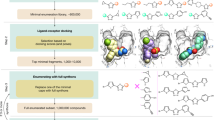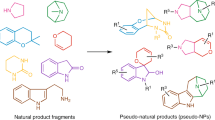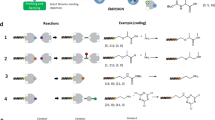Abstract
The structure- and chemistry-based hierarchical organization of library scaffolds in tree-like arrangements provides a valid, intuitive means to map and navigate chemical space. We demonstrate that scaffold trees built using bioactivity as the key selection criterion for structural simplification during tree construction allow efficient and intuitive mapping, visualization and navigation of the chemical space defined by a given library, which in turn allows correlation of this chemical space with the investigated bioactivity and further compound design. Brachiation along the branches of such trees from structurally complex to simple scaffolds with retained yet varying bioactivity is feasible at high frequency for the five major pharmaceutically relevant target classes and allows for the identification of new inhibitor types for a given target. We provide proof of principle by identifying new active scaffolds for 5-lipoxygenase and the estrogen receptor ERα.
This is a preview of subscription content, access via your institution
Access options
Subscribe to this journal
Receive 12 print issues and online access
$259.00 per year
only $21.58 per issue
Buy this article
- Purchase on Springer Link
- Instant access to full article PDF
Prices may be subject to local taxes which are calculated during checkout





Similar content being viewed by others
References
Koch, M.A. et al. Charting biologically relevant chemical space: a structural classification of natural products (SCONP). Proc. Natl. Acad. Sci. USA 102, 17272–17277 (2005).
Schuffenhauer, A. et al. The scaffold tree - visualization of the scaffold universe by hierarchical scaffold classification. J. Chem. Inf. Model. 47, 47–58 (2007).
Clark, A.M. & Labute, P. Detection and assignment of common scaffolds in project databases of lead molecules. J. Med. Chem. 52, 469–483 (2009).
Kaiser, M., Wetzel, S., Kumar, K. & Waldmann, H. Biology-inspired synthesis of compound libraries. Cell. Mol. Life Sci. 65, 1186–1201 (2008).
Nören-Müller, A. et al. Discovery of protein phosphatase inhibitor classes by biology-oriented synthesis. Proc. Natl. Acad. Sci. USA 103, 10606–10611 (2006).
Nören-Müller, A. et al. Discovery of a new class of inhibitors of Mycobacterium tuberculosis protein tyrosine phosphatase B by biology-oriented synthesis. Angew. Chem. Int. Ed. 47, 5973–5977 (2008).
Schuffenhauer, A. et al. Clustering and rule-based classifications of chemical structures evaluated in the biological activity space. J. Chem. Inf. Model. 47, 325–336 (2007).
Johnson, A.M. & Maggiora, G.M. Concepts and Applications of Molecular Similarity (Wiley, New York, 1990).
Hajduk, P.J. & Greer, J. A decade of fragment-based drug design: strategic advances and lessons learned. Nat. Rev. Drug Discov. 6, 211–219 (2007).
Siegel, M.G. & Vieth, M. Drugs in other drugs: a new look at drugs as fragments. Drug Discov. Today 12, 71–79 (2007).
Olah, M. et al. WOMBAT: world of molecular bioactivity. in Chemoinformatics in Drug Discovery (ed. Oprea, T.I.) 223–239 (Wiley-VCH, Weinheim, Germany, 2004).
Olah, M. et al. WOMBAT and WOMBAT-PK: bioactivity databases for lead and drug discovery. in Chemical Biology: from Small Molecules to Systems Biology and Drug Design (eds. Schreiber, S.L., Kapoor, T.M. & Wess, G.) 760–786 (Wiley-VCH, Weinheim, Germany, 2007).
Loewi, O. & Navratil, E. Humoral transmissability of the cardiac neural effect. XI. Announcement. The mechanism of the vagal effect of physostigmine and ergotamine. Pflugers Arch. Gesamte Physiol. Menschen Tiere 214, 689–696 (1936).
Schechter, I. & Berger, A. On the size of the active site in proteases. I. Papain. Biochem. Biophys. Res. Commun. 27, 157–162 (1967).
Ersmark, K., Del Valle, J.R. & Hanessian, S. Chemistry and biology of the aeruginosin family of serine protease inhibitors. Angew. Chem. Int. Edn Engl. 47, 1202–1223 (2008).
Wiley, M.R. & Fisher, M.J. Small-molecule direct thrombin inhibitors. Expert Opin. Ther. Pat. 7, 1265–1282 (1997).
Löwe, J., Li, H., Downing, K.H. & Nogales, E. Refined structure of alpha beta-tubulin at 3.5 A resolution. J. Mol. Biol. 313, 1045–1057 (2001).
Kingston, D.G.I. The shape of things to come: structural and synthetic studies of taxol and related compounds. Phytochemistry 68, 1844–1854 (2007).
Schulz, W. Chemical Abstracts Service launches release 2.0 of innovative SciFinder. Chem. Eng. News 74, 43 (1996).
Staker, B.L. et al. The mechanism of topoisomerase I poisoning by a camptothecin analog. Proc. Natl. Acad. Sci. USA 99, 15387–15392 (2002).
Ducharme, Y. et al. Naphthalenic lignan lactones as selective, nonredox 5-lipoxygenase inhibitors - synthesis and biological-activity of (methoxyalkyl)thiazole and methoxytetrahydropyran hybrids. J. Med. Chem. 37, 512–518 (1994).
Hopkins, A.L., Groom, C.R. & Alex, A. Ligand efficiency: a useful metric for lead selection. Drug Discov. Today 9, 430–431 (2004).
Bourguet, W., Germain, P. & Gronemeyer, H. Nuclear receptor ligand-binding domains three-dimensional structures, molecular interactions and pharmacological implications. Trends Pharmacol. Sci. 21, 381–388 (2000).
Hoekstra, W.J. et al. Discovery of novel quinoline-based estrogen receptor ligands using peptide interaction profiling. J. Med. Chem. 48, 2243–2247 (2005).
Bologa, C.G. et al. Virtual and biomolecular screening converge on a selective agonist for GPR30. Nat. Chem. Biol. 2, 207–212 (2006).
Sadler, B.R. et al. Three-dimensional quantitative structure-activity relationship study of nonsteroidal estrogen receptor ligands using the comparative molecular field analysis cross-validated r(2)-guided region selection approach. J. Med. Chem. 41, 2261–2267 (1998).
Chesworth, R. et al. Tetrahydroisoquinolines as subtype selective estrogen agonists/antagonists. Bioorg. Med. Chem. Lett. 14, 2729–2733 (2004).
Hopkins, A.L., Mason, J.S. & Overington, J.P. Can we rationally design promiscuous drugs? Curr. Opin. Struct. Biol. 16, 127–136 (2006).
Nidhi, Glick, M., Davies, J.W. & Jenkins, J.L. Prediction of biological targets for compounds using multiple-category Bayesian models trained on chemogenomics databases. J. Chem. Inf. Model. 46, 1124–1133 (2006).
Fattori, D. Molecular recognition: the fragment approach in lead generation. Drug Discov. Today 9, 229–238 (2004).
Acknowledgements
This research was supported by the Max-Planck-Gesellschaft and the Fonds der Chemischen Industrie. Part of this work was supported by US National Institutes of Health grants 1R01CA127731 and 1U54MH084690 (to T.I.O.) and by the German Federal Ministry for Education and Research through the German National Genome Research Network-Plus (grant number BMBF 01GS08102, to D.R. and H.W.). W.A.L.v.O. thanks the Alexander von Humboldt Foundation for a Georg Forster Research Fellowship for Experienced Researchers.
Author information
Authors and Affiliations
Corresponding author
Ethics declarations
Competing interests
T.I.O. is the owner of Sunset Molecular, the distributor of the WOMBAT database that we used in our studies.
Supplementary information
Supplementary Text and Figures
Supplementary Figures 1–5 and Supplementary Methods (PDF 638 kb)
Rights and permissions
About this article
Cite this article
Renner, S., van Otterlo, W., Dominguez Seoane, M. et al. Bioactivity-guided mapping and navigation of chemical space. Nat Chem Biol 5, 585–592 (2009). https://doi.org/10.1038/nchembio.188
Received:
Accepted:
Published:
Issue Date:
DOI: https://doi.org/10.1038/nchembio.188
This article is cited by
-
A molecule perturbation software library and its application to study the effects of molecular design constraints
Journal of Cheminformatics (2023)
-
Adapting the DeepSARM approach for dual-target ligand design
Journal of Computer-Aided Molecular Design (2021)
-
Scaffold Hunter: a comprehensive visual analytics framework for drug discovery
Journal of Cheminformatics (2017)
-
Counting on natural products for drug design
Nature Chemistry (2016)
-
De novo branching cascades for structural and functional diversity in small molecules
Nature Communications (2015)



